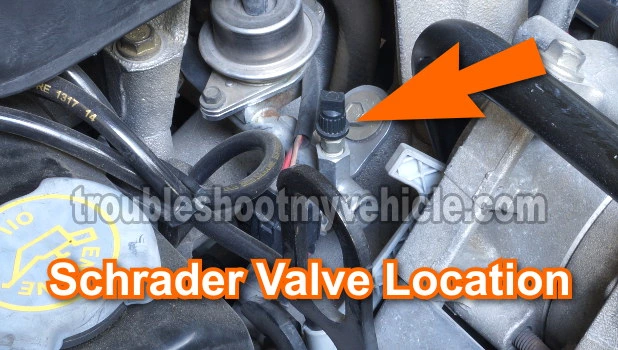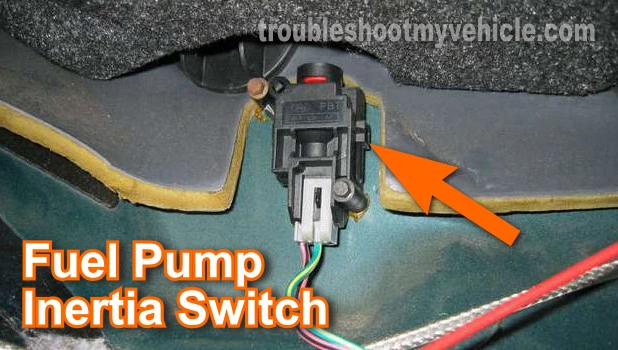
As you're probably already aware, the engine in your 2.3L Ford Ranger (Mustang, Mazda B2300) needs 3 things to start. These are fuel, air and spark.
The major component that provides the fuel the engine needs to start is the in-tank electric fuel pump.
Testing it isn't difficult and in this tutorial I'll give you some pointers on how to do it and more importantly, the fuel pressure specifications of the fuel pump.
Contents of this tutorial:
APPLIES TO: This tutorial applies to the following vehicles:
- 2.3L Ford Mustang: 1990, 1991, 1992, 1993.
- 2.3L Ford Ranger: 1990, 1991, 1992, 1993, 1994, 1995, 1996, 1997.
- 2.3L Mazda B2300: 1994, 1995, 1996, 1997.
ES ![]() You can find this tutorial in Spanish here: Cómo Probar La Bomba de Gasolina (1990-1997 2.3L Ford) (at: autotecnico-online.com).
You can find this tutorial in Spanish here: Cómo Probar La Bomba de Gasolina (1990-1997 2.3L Ford) (at: autotecnico-online.com).
Symptoms Of A Bad Fuel Pump
When the fuel pump, in your 2.3L Ford Ranger (Mustang, Mazda B2300) fails, it'll generally fail in one of two ways:
- Engine Cranks But Does Not Start: The fuel pump stops working completely (producing no fuel pressure) and although the engine turns over, it won't start.
- Engine Starts But Run Bad: The fuel pump is failing but still produces enough fuel pressure to start the engine. Unfortunately, it's not enough fuel pressure to pump the volume of fuel the engine needs to run under load (like driving).
These are the symptoms that you'll see when the fuel pump has failed or is starting to fail:
- Engine No Start: The starter motor cranks the engine but it won't start.
- Stalling After Start: The engine starts but shuts off after a few seconds of run time.
- Stalling On Acceleration: The engine starts but as soon as you step on the accelerator pedal, the engine stalls.
- No Power Under Load: Lack of power while driving the vehicle.
- Backfiring: Explosions (loud popping sounds) can be heard coming from the intake manifold when you step on the accelerator while the engine is under load.
- Check Engine Light Illuminated: The check engine light is on, and lean air-fuel mixture trouble codes are stored in the fuel injection computer's memory.
I want to point out before moving on the next heading, that other components (when they fail) can also cause similar problems/symptoms and mimic a failing fuel pump. One of these is the fuel pump inertia switch, which when activated, will shut off power to the fuel pump. To find out more about the fuel pump inertia switch, see this section: Checking The Fuel Pump Inertia Switch.
The Two Methods To Troubleshoot The Fuel Pump
There are two very basic ways to find out if the no-start your 2.3L Ford Ranger (Mustang, Mazda B2300) is being caused by a lack of fuel (a bad fuel pump).
One way involves using starting fluid and the other involves using a fuel pressure test gauge.
Both test tests are effective but the most accurate of the two is the checking for a lack of fuel with a fuel pressure test gauge.
Using A Fuel Pressure Gauge: This is the more accurate of both tests.
Ford was kind enough to install a Schrader valve on the fuel injector rail where you and I can install a fuel pressure gauge and measure the exact fuel pressure the fuel pump is outputting while the vehicle is being cranked.
Using Starting Fluid: The idea behind using starting fluid is to use the fluid as a substitute for gasoline.
The starting fluid is sprayed into the throttle body and then the engine is cranked. If the no-start is being caused by a lack of fuel, the engine will start. Now, it won't stay running, because as soon as the starting fluid that was sprayed in the throttle body is consumed, the engine will stall and cut off.
Although the engine doesn't stay running, this test result is enough to tells you that your 2.3L Ford Ranger's no-start problem is due to a lack of fuel (probably from the fuel pump).
IMPORTANT: Gasoline and starting fluid are extremely flammable. Take all necessary safety precautions while working around fuel. Safety is your responsibility. Be careful, stay alert, and use common sense.
Where To Buy A Fuel Pressure Test Gauge And Save
The following fuel pressure test gauge kits have the adapter that'll connect the Ford style Schrader valve on the fuel rail of your Ford Ranger (Mustang, Mazda B2300):
Disclosure: As an Amazon Associate, I earn from qualifying purchases. If my tutorials help you, using these links is an easy way to support the site at no extra cost to you. Thank you!
TEST 1: Using A Fuel Pressure Gauge To Check Fuel Pressure
As mentioned earlier, the most accurate way of testing the fuel pump is with a fuel pressure test gauge. This is due to the fact that you're able to get a direct measurement of the fuel pressure the fuel pump is producing and compare it to the factory specification.
This fuel pressure measurement gives you a clear indication of whether the fuel pump is delivering the correct amount of pressure to the engine. If the pressure is too low or non-existent, you can conclude that there's a problem with the fuel pump or the fuel system.
What makes testing the fuel pump's pressure output a piece of cake is that we can connect a fuel pressure gauge to the engine's fuel pressure test port (called a Schrader valve) on the fuel injector rail.
In case you're wondering what the Schrader valve looks like, the Schrader valve looks like a tire valve stem and it's located on the fuel injector rail (the fuel injector rail is what holds all 4 injector in place on the intake manifold). See photo 1 of 2 above.
IMPORTANT: Before you start your fuel pump pressure test, check that the fuel pump inertia switch hasn't been activated. The purpose of this switch is to shut off the fuel pump in the event of a collision or sudden impact. See this section for more info: Checking The Fuel Pump Inertia Switch.
OK, let's get started with this test:
- 1
Locate the Schrader valve on the fuel injector rail.
- 2
Remove the dust cap from the Schrader valve and place a shop towel under the general area of the Schrader valve.
NOTE: The shop towel's job is to absorb and fuel that may leak when performing step 3. - 3
Connect the fuel pressure gauge to the Schrader valve on the fuel injector rail.
- 4
When ready, ask your helper to cycle the key on and off but don't crank the engine while you observe the fuel pressure tester's gauge.
Check the connection at the Schrader valve for fuel leaks and if any tighten the fuel pressure a bit more (by hand only) to eliminate them. - 5
Your fuel pressure gauge should register: 35 to 45 PSI with the Key On Engine Off (KOEO) if the fuel pump is OK.
OK, now that the testing part is done, let's take a look at what your results mean:
CASE 1: If the fuel pressure gauge registered 0 PSI. This confirms that the cause of your 2.3L Ford Ranger's no-start problem is caused by a lack of fuel.
Now, I usually take one more precaution, before condemning the fuel pump as bad and this is to check that the fuel pump is getting 12 Volts as the engine is cranking. This is just to make sure that the fuel pump relay and fuse are OK and doing their job.
What you'll have to do to accomplish this is to attach a multimeter in Volts DC mode to the wire that supplies this voltage to the fuel pump and while a helper cranks the engine, verify that the fuel pump is getting this power. If the 12 Volts are being supplied to the fuel pump, you have now 100% verified that the fuel pump is fried and needs to be replaced.
CASE 2: If the fuel pressure gauge registered 35 to 45 PSI: This fuel pressure gauge result lets you know that the fuel pump is working and delivering enough fuel to the fuel injectors. The reason your 2.3L Ford vehicle is not starting is due to another reason. The fuel pump is OK.
Checking The Fuel Pump Inertia Switch

Your Ford comes equipped with a fuel pump inertia switch, whose job is to cut power (or Ground) to the fuel pump in case of an impact.
When the inertia switch is jolted into action, the engine won't start (or if it was running will stall) due to a lack of fuel.
Although it's designed to activate during a severe impact cause by an automobile accident, sometimes it gets activated by less than severe impacts. This means that it's always a good idea to check and reset the inertia switch whenever testing the fuel pump.
Resetting the fuel pump inertia switch simply involves pushing down on the button located on top of the inertia switch till it bottoms out.
TEST 2: Using Starting Fluid To Confirm A Lack Of Fuel

As mentioned earlier, the idea behind using starting fluid is to confirm that a lack of fuel is causing your 2.3L Ford Ranger (Mustang or Mazda B2300) to crank but not start.
This is usually the very first thing that most techs will do when they suspect that the fuel pump is bad (or that the no-start problem is due to a lack of fuel).
NOTE: To get an accurate test result from the starting fluid test, you need to first check and confirm that the ignition system on your 2.3L Ford Ranger (Mustang or B2300) is creating and feeding spark to all 4 cylinders. Without spark already present... The starting fluid test won't prove or disprove that a lack of fuel is the problem behind the no-start condition.
IMPORTANT: This is a very fast and easy test but you do have to take one very important safety precaution and this is to reconnect the air intake duct after spraying starting fluid down the throttle bore (although you don't have to fasten it). This will prevent any backfire, that might occur, from scaring the heck out of you when cranking the engine.
This is what you have to do:
- 1
Remove the intake air duct from the throttle body. You don't have to completely remove it, since you'll have to reconnect it in one of the next steps.
- 2
Open the throttle plate and spray starting fluid down the bore.
As a safety precaution reconnect the air duct after you have sprayed a good squirt of starting fluid (but you don't have to tighten the air duct's hose clamp). - 3
Crank the engine once the air duct is back on and you're clear of the engine compartment.
- 4
You'll get one of two results with this test:
1.) The engine will start momentarily and after a few seconds will die or.
2.) The engine will only crank but not start at all.
OK, let's find out what your results mean:
CASE 1: If the engine started and ran for a few seconds. This test result tells you that the reason your 2.3L Ford Ranger (Mustang, Mazda B2300) is cranking but NOT starting is due to a lack of fuel.
CASE 2: The engine did not start, not even momentarily. This usually means that a lack of fuel IS NOT the reason your car is not starting.
Now, remember what I said about this test not being very accurate? Well, I suggest you do one more test and this is to check the fuel pressure with a fuel pressure test gauge.

If this info saved the day, buy me a beer!






